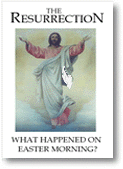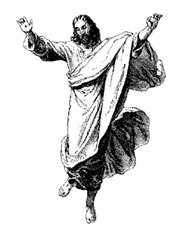
|
|

|
|
First of all let me say that I do think that the Resurrection was real. By that I mean that it was not an event that was simply invented or faked by Jesus' followers. I do think that Jesus was "crucified under Pontius Pilate," that he "suffered death and was buried," and "on the third day he rose again," as the Nicene Creed states. However, I do not think that the Resurrection involved Jesus' body coming back to life. By that I mean that the Resurrection was not simply resuscitation -- as if Jesus somehow simply recovered from the crucifixion. Even further, I find it highly unlikely that the Resurrection involved Jesus taking up his old body in any sense. To me the Resurrection was a completely transformative event, one in which Jesus took on a wholly different existence from the one he had on earth. Now, I do think that a literal reading of the Gospels comes to the conclusion that the Resurrection was a physical event. Luke makes that abundantly clear in his gospel (24:39), and Matthew and John give a similar impression (Matt. 28:9; John 20:24-29, 21:9-14). But whether these passages should be interpreted literally is still an open question in my mind. And given a few features of the text, and a number of scientific presumptions, I think these passages probably shouldn't be interpreted literally. I always like to approach the text from a chronological stand-point; that is, I like to take each text in order, from the earliest to the latest, based on when each text was written. The first person we always begin with, then, is Paul. Paul's View of the Resurrection 1 Corinthians 15 is the central text for Paul on this topic. He mentions Jesus' resurrection, but in a matter-of-fact way that tells us only that Jesus "appeared" to various followers after he was "raised on the third day" (15:4-7). He includes in this list his own experience of the risen Christ (15:8), making no distinction between Jesus' appearance on the road to Damascus and Jesus' earlier appearances to the apostles (cf. 9:1). This is telling since Paul's own experience of the resurrected Christ was that of a vision, complete with photism and audition, but wholly without an engagement with a physical form (Acts 9:3-6, 22:6-10, 26:13-18). While this does not mean that Paul's experience was necessarily identical with that of the apostles, it does raise the question of whether these "appearances" to the other followers were visions as well. Some scholars think that the appearance to "over five hundred brothers and sisters at one time" (1 Cor. 15:6) is a reference to Pentecost, which may be highly revealing of Christology in the early Church (cf. 2 Cor. 3:17).
The new body is not simply the old body made immortal: "you do not sow the body that is to be" (1Cor. 15:37). Rather, the new spirit-body is as different from the physical body as a full-grown plant is different from a seed (15:37-38). While Paul must see some continuation between the old and the new bodies, the discontinuity of the two is underscored even further by Paul's statement that, "if the earthly tent we live in is destroyed, we have a building from God, a house not made with hands, eternal in the heavens" (2Cor. 5:1). It seems that Paul conceives of this spirit-body as a separate creation in heaven, which will be created and inhabited when the time comes. Jesus as "Spirit" Together with Paul's experience of Christ as a non-physical entity, these passages seem to indicate that Paul thinks of the resurrected life -- whether that of Jesus now, or of our future existence at the end of time -- as a spiritual existence apart from the old physical body. In addition, he mentions specifically that Jesus "became a life-giving spirit" (15:45). So too, Peter, our next author chronologically, mentions that Jesus was "put to death in the flesh, but made alive in the spirit" (1Pet. 3:18). Notice the dichotomy presented: death is the opposite of life, as flesh is the opposite of spirit. The NIV renders the text as "made alive in the Spirit" (i.e., the
Of course, the above is my own interpretation of the passages presented, and one that is not shared by all commentators. The passages are not 100% clear on the issue. But what is clear is that there has been nothing conclusive thus far (dated roughly from 50 A.D to 70 A.D.) to indicate that the earliest Christian writers thought of Christ's resurrection as physical -- at least nothing like that found in the Gospels. In fact, much of the evidence thus far lends itself better to a non-physical Resurrection. From 70 A.D. on, however, we are confronted with the Gospels (Mark being the first), and here the argument for a physical Resurrection takes a dramatic turn. The Gospels The earliest version of Mark (ending with verse 16:8) does not make any mention of post-mortem appearances. Instead, Mark presents us with the story of the empty tomb. While this account does not explicitly make the claim that Christ's resurrection was physical, it does imply such a belief. The tradition of the empty tomb is a controversial one. Conservative scholars have pointed out several facets of the story that they feel favor its historicity. However, there are elements of the burial tradition that suggest it was of late composition. First of all, Mark is the first to mention the empty tomb. Paul simply tells us that Jesus "was buried, and that he was raised on the third day" (1Cor. 15:4). Some consider this to be evidence that the tradition of the empty tomb was not known to Paul -- of course, arguments from silence are hard to prove. However, the fact that Paul tells us that Jesus first appeared to Peter (1Cor. 15:5; cf. Luke 24:34),
On a more speculative note, Mark's account may not be the only tradition concerning Jesus' burial. Some liberal scholars think that they have discovered a different tradition, one in which Jesus' enemies (the Jewish authorities) bury Jesus. A Coptic text from the second century, known as the Epistula Apostolorum, may include the entire tradition, while John 19:31 is thought to be a remnant. A fourth century text written by a man named Lactinius and Acts 13:27-29 both give a similar impression. A Ghost Has Not Flesh and Bones This brings us to the physical appearances of Christ in the other gospels (Luke 24:39; Matt. 28:9; John 20:24-29, 21:9-14). Taken literally they speak of a physical resurrection. However, the stories also give the impression that we are dealing with what Marcus Borg describes as "non-ordinary reality and non-ordinary perception." While those portions of the Gospels that speak of Jesus' earthly ministry relate a continuous, harmonious account, and show a great deal of agreement and overlap, the Resurrection accounts are isolated, disconnected, and different in all four gospels. Jesus appears suddenly to people, as in a vision (Matt. 28:9). He passes through walls, or otherwise materializes and dematerializes (John 20:19, 26; Luke 24:31, 36). He takes on "another form" in one appearance (Mark 16:12), and those who encounter him do not always recognize him (Matt. 28:17; Luke 24:13-35). This last example I find especially telling. If Jesus took up his old body again, why is it that people do not recognize him? Like the empty tomb, I think that these passages are meant to be metaphors of the Resurrection. As such, they help explain an event that is otherwise unexplainable: at no time before or since this event has anyone experienced the resurrection of an individual. I don't believe any words can adequately describe it. The message of these passages is that Jesus was really and truly present among his followers after his death. Since our perception of what is real is primarily grounded in the physical, it would be a natural metaphor. They also reveal "non-ordinary perception." Christ can be "touched" and "felt," but only in a mystical sense. What is the Body of Christ? An important thing to keep in mind is that there are other ways in which Christ's body is real to us. Throughout his letters, Paul develops the idea that it is the Christian community that is the "Body of Christ" (Rom. 12:15; 1Cor. 12:12-31; Col. 1:18, 2:19; Eph. 1:23, 4:15, 5:23). The eucharistic bread as the body of Christ (Luke 22:19), and Luke's statement that it is in the "breaking of the bread" (Luke 24:35) that the risen Christ is known, is also revealing. How far Paul saw the Church as the physical extension of Christ's spiritual body, and Luke likewise in the sacrament, is hard to tell. But they do represent physical realities that can be experienced as Christ's body.
Conclusion Limited knowledge keeps me from saying with absolute certainty that Christ's resurrection did not involve an empty tomb or the transformation of his old physical body into a "glorified" physical body. However, I think there is enough in the Gospels that challenge the idea of a physical resurrection. In addition, like most liberal theologians, I am eager to align myself with what I perceive to be Paul's position: Jesus' resurrection involved a spirit-body rather than a physical body. His metaphor of the Church as the Body of Christ, and the Gospel authors' view of the Eucharist as the Body of Christ, I think also suggests this idea.
|






